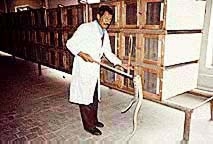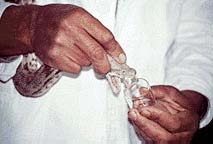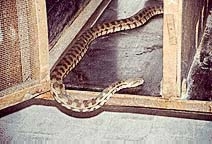
Summer 1995 (3.2)
Droplets
of Life or Death
The Venom
of Caucasian Vipers
by
Mark Hopkins




Above left: Snakes
are kept as pairs in cages with controlled temperature. Here
a specialist carefully lifts the snake out of its cage with a
stick. Snake venom is used for medicinal purposes. The venom
of Caucasian Vipers of Azerbaijan has a special ability to stop
bleeding in extremely difficult cases when nothing else works.
Above
right: Milking the Snake. With extreme attention
and caution, the specialist holds the jaws of the snake open
with his thumb and middle finger while controlling the snake's
head with his forefinger. With his other hand he holds glass
vial under the fangs to collect the venom. Another assistant
applies a slight electric shock (varying from two to five watts
according to the size of the snake) for a brief one or two seconds.
The process is extremely quick. When shocked, the snake reacts
and releases a few drops of venom.
Bottom
left: Caucasian Viper.
Bottom
right:
The venom liquid is weighed
and documented. The venom drying process takes about four or
five days. The vial is placed in a larger basin which filled
with moisture absorbers.
These days, most people associate resources in Azerbaijan with
the vast reserves of oil and gas in the Caspian Sea. Even the
name, Azerbaijan, is becoming synonymous with oil. Executives
speak in terms of the potential of millions and billions of barrels
of oil which interpreted, of course, means millions and billions
of dollars.
But Azerbaijan has another resource that is literally produced
in single droplets. It's snake venom, and it may well be the
most expensive liquid produced in nature. Depending upon demand
and accessibility to international markets, venom (in its dry
crystallized form) can bring between $1,000 to $1,500 per gram.
In other words, potentially up to $1 million or more per kilo.
These days that would mean selling, at least, 50,000 barrels
of oil!
Caucasian Vipers
Azerbaijanis are operating
two snake farms where they collect and process venom. One is
close to Baku in Aksu near the Jeyran Batan Reservoir. And the
other is located east of Baku at the tip of the Absheron Peninsula
near the Caspian Sea. The Director of the lab there, Herpatologist
Akif Maharramov, says that annually they're able to collect and
process about four kilograms of venom.
Armenians also claim to be milking
venom from snakes on the Azerbaijan territory that they are occupying
in Karabakh. They boast an annual volume of one kilo (Armenian
International Magazine, Jan-Feb 1994).
Maharramov's lab, the Venom Producing Herpetology Center, was
established in 1969 under the USSR Pharmacological Production
Association. During the Soviet period, 60% of all venom produced
in the USSR came from Azerbaijan and was distributed to various
factories and research centers throughout the USSR. Now this
lab comes under the authority of the Health Ministry of Azerbaijan
Republic.
Prior to World War II, snakes were kept at the Institute of Microbiology,
where the first anti-venom for snake bite was produced in the
USSR. After the war, the Institute was moved to Tashkent (Uzbekistan).
Now similar centers exist in Central Asia. Such enterprises have
also developed in Iran and India although the world's largest
laboratory is in Brazil at a center that began in 1888.
Medicinal Purposes
Snake venom has been
used for medical purposes for thousands of years and is generally
classified according to the system of the body that it affects.
Though the terms-hematoxic, neurotoxic, and cardiotoxic-are somewhat
misleading because of their simplicity in categorizing the effect
the venoms, it is accurate to say that some of the components
of these poisons can cause changes in the red blood cells, coagulation,
and blood vessels; while others attack the sensory and motor
functions, particularly respiration; and still others directly
affect the heart.
Cobras, for example, produce a venom that affects the nervous
system. In Azerbaijan,
the venom of the Caucasian Viper (known as "Gurza")
which they collect which has a powerful effect on blood. Injected
in small increments, it can stop bleeding when nothing else will,
such as in surgery and abortions.
On its own, the "Gurza" venom does not penetrate skin,
but in an ointment preparation, it can be absorbed deep into
the connective tissues. Therefore, it is usually prepared as
an anesthetic ointment. Generally, a preparation of 100 grams
of ointment contains 0.5 -1 mg of venom or a ratio of about 1:100,000.
This venom can also be used for hypodermic and internal muscular
conditions, in case of weakness of the body, or for diseases
of the joints in such ailments as rheumatism. The Azerbaijanis
scientists are now beginning to experiment combining snake venom
and medicinal herbs.
Snakes in Captivity
At any give time, the
Center keeps about 350 Caucasian vipers, all of which have been
gathered in Azerbaijan. The snakes are treated with great sensitivity
and care. Each one is registered with the government. They're
measured, weighed, examined and kept isolated and quarantined
until proven that they're healthy. The standard acceptable size
of the snakes acceptable for the lab is 80 cm. It used to be
65 cm. until they realized that snakes can breed twice during
the period of time that it takes to grow 15 cm. Currently the
longest snake in the center is 120-130 cm. However, in nature,
they can sometimes be found to be 160-170 cm. The natural life
span of vipers is believed to be 40-50 years.
After being held in captivity for about 14-18 months, the snakes
are released back to nature. They are never killed. They are
not kept for longer periods since it has been found that readjustment
is more difficult for them. In captivity, they get used to not
having to search for their own food supply. Also the lack of
variety in their diet during captivity can lead to deficiencies
and illnesses.
In nature, snakes usually feed on rodents, birds and, on occasion,
even their own species. Under laboratory conditions, they are
fed three or four different kinds of food, basically healthy
white mice bred in the laboratory, one-day old chickens, and
other types of birds. In the summertime, Spanish sparrows which
are considered to be pests to agriculture are used.
Collecting the
Venom
The amount of venom
released by a Caucasian Viper depends upon its size. Obviously,
the larger the snake, the more venom it can produce. For example,
an 80 cm. snake can give approximately 30 mg. of poison; a snake
of 120-130 cm. gives about 80 mg. But there are a number of factors
that can also influence the amount which is produced. Snakes
are more passive in winter and can only give venom about every
30 days; in the summer, it's possible every 20 days. The average
annual production per snake in these Azerbaijani laboratories
is about 1,000 mg. of dry, crystallized venom although there
have been occasions when a snake has given 1,600 mg., but such
cases are rare.
A coded glass vial is used for collecting the venom of each snake
and a record is made of the production (weight, date, etc). At
a later stage, the liquid venom is dried as crystals. This drying
process also has its own norms. Generally, the venom should not
dry at a rate of more than 4.5 times. If it does, the lab specialists
check to see whether the snake is diseased and needs to be isolated.
They then try to restore it to health by giving antibiotics and
vitamins.
Risks
Of course, working in
a snake laboratory is not without its own risks. Maharramov insists
that snakes are harmless unless you touch or corner them. In
ancient times, he says they were even used as guards. "If
you don't pay attention to snakes, they won't bother you."
That's why Maharramov wishes there were laws to protect snakes
so people wouldn't automatically rush to kill them. "It's
going to take a long time to counter the mythology that surrounds
snakes. People need to realize that these creatures provide beneficial,
life-saving and healing resources for human health."
But still in the lab, when it's time for collecting the venom,
when the specialists are holding the snake's head in position
with jaws locked open wide, there's a tension that fills the
air, and everyone proceeds very cautiously but very quickly.
No one ever forgets that venom can kill. It's not uncommon to
see someone who has worked a lot around snakes who has lost the
top digit of a finger. If no anti-serums are readily available,
it's often a choice between amputation or life.
Prospects Today
During the Soviet period,
venom used to be organized, produced and distributed by the State
Planning Committee. Today, there's a severe economic crisis going
on in Azerbaijan which hinders the ability of such labs to find
and gain access to international markets. That's the main problem
right now-finding markets and being able to compete with smugglers
who have taken over the control of venom in many countries (including
Azerbaijan), and who willingly sell it at much lower prices than
could be demanded on the world market.
Home | About
Azeri | Learn
Azeri | Arabic
Script | Store | Contact
us
Articles from Azerbaijan
International
© Azerbaijan International. Copyright 2003. All rights reserved.
|
|
 |
 |
 |
 |
Above left: Snakes are kept as pairs in cages with controlled temperature. Here a specialist carefully lifts the snake out of its cage with a stick. Snake venom is used for medicinal purposes. The venom of Caucasian Vipers of Azerbaijan has a special ability to stop bleeding in extremely difficult cases when nothing else works.
Above right: Milking the Snake. With extreme attention and caution, the specialist holds the jaws of the snake open with his thumb and middle finger while controlling the snake's head with his forefinger. With his other hand he holds glass vial under the fangs to collect the venom. Another assistant applies a slight electric shock (varying from two to five watts according to the size of the snake) for a brief one or two seconds. The process is extremely quick. When shocked, the snake reacts and releases a few drops of venom.
Bottom left: Caucasian Viper.
Bottom right: The venom liquid is weighed and documented. The venom drying process takes about four or five days. The vial is placed in a larger basin which filled with moisture absorbers.
These days, most people associate resources in Azerbaijan with the vast reserves of oil and gas in the Caspian Sea. Even the name, Azerbaijan, is becoming synonymous with oil. Executives speak in terms of the potential of millions and billions of barrels of oil which interpreted, of course, means millions and billions of dollars.
But Azerbaijan has another resource that is literally produced in single droplets. It's snake venom, and it may well be the most expensive liquid produced in nature. Depending upon demand and accessibility to international markets, venom (in its dry crystallized form) can bring between $1,000 to $1,500 per gram. In other words, potentially up to $1 million or more per kilo. These days that would mean selling, at least, 50,000 barrels of oil!
Caucasian Vipers
Azerbaijanis are operating
two snake farms where they collect and process venom. One is
close to Baku in Aksu near the Jeyran Batan Reservoir. And the
other is located east of Baku at the tip of the Absheron Peninsula
near the Caspian Sea. The Director of the lab there, Herpatologist
Akif Maharramov, says that annually they're able to collect and
process about four kilograms of venom.
Armenians also claim to be milking
venom from snakes on the Azerbaijan territory that they are occupying
in Karabakh. They boast an annual volume of one kilo (Armenian
International Magazine, Jan-Feb 1994).
Maharramov's lab, the Venom Producing Herpetology Center, was
established in 1969 under the USSR Pharmacological Production
Association. During the Soviet period, 60% of all venom produced
in the USSR came from Azerbaijan and was distributed to various
factories and research centers throughout the USSR. Now this
lab comes under the authority of the Health Ministry of Azerbaijan
Republic.
Prior to World War II, snakes were kept at the Institute of Microbiology,
where the first anti-venom for snake bite was produced in the
USSR. After the war, the Institute was moved to Tashkent (Uzbekistan).
Now similar centers exist in Central Asia. Such enterprises have
also developed in Iran and India although the world's largest
laboratory is in Brazil at a center that began in 1888.
Medicinal Purposes
Snake venom has been
used for medical purposes for thousands of years and is generally
classified according to the system of the body that it affects.
Though the terms-hematoxic, neurotoxic, and cardiotoxic-are somewhat
misleading because of their simplicity in categorizing the effect
the venoms, it is accurate to say that some of the components
of these poisons can cause changes in the red blood cells, coagulation,
and blood vessels; while others attack the sensory and motor
functions, particularly respiration; and still others directly
affect the heart.
Cobras, for example, produce a venom that affects the nervous
system. In Azerbaijan,
the venom of the Caucasian Viper (known as "Gurza")
which they collect which has a powerful effect on blood. Injected
in small increments, it can stop bleeding when nothing else will,
such as in surgery and abortions.
On its own, the "Gurza" venom does not penetrate skin,
but in an ointment preparation, it can be absorbed deep into
the connective tissues. Therefore, it is usually prepared as
an anesthetic ointment. Generally, a preparation of 100 grams
of ointment contains 0.5 -1 mg of venom or a ratio of about 1:100,000.
This venom can also be used for hypodermic and internal muscular
conditions, in case of weakness of the body, or for diseases
of the joints in such ailments as rheumatism. The Azerbaijanis
scientists are now beginning to experiment combining snake venom
and medicinal herbs.
Snakes in Captivity
At any give time, the
Center keeps about 350 Caucasian vipers, all of which have been
gathered in Azerbaijan. The snakes are treated with great sensitivity
and care. Each one is registered with the government. They're
measured, weighed, examined and kept isolated and quarantined
until proven that they're healthy. The standard acceptable size
of the snakes acceptable for the lab is 80 cm. It used to be
65 cm. until they realized that snakes can breed twice during
the period of time that it takes to grow 15 cm. Currently the
longest snake in the center is 120-130 cm. However, in nature,
they can sometimes be found to be 160-170 cm. The natural life
span of vipers is believed to be 40-50 years.
After being held in captivity for about 14-18 months, the snakes
are released back to nature. They are never killed. They are
not kept for longer periods since it has been found that readjustment
is more difficult for them. In captivity, they get used to not
having to search for their own food supply. Also the lack of
variety in their diet during captivity can lead to deficiencies
and illnesses.
In nature, snakes usually feed on rodents, birds and, on occasion,
even their own species. Under laboratory conditions, they are
fed three or four different kinds of food, basically healthy
white mice bred in the laboratory, one-day old chickens, and
other types of birds. In the summertime, Spanish sparrows which
are considered to be pests to agriculture are used.
Collecting the
Venom
The amount of venom
released by a Caucasian Viper depends upon its size. Obviously,
the larger the snake, the more venom it can produce. For example,
an 80 cm. snake can give approximately 30 mg. of poison; a snake
of 120-130 cm. gives about 80 mg. But there are a number of factors
that can also influence the amount which is produced. Snakes
are more passive in winter and can only give venom about every
30 days; in the summer, it's possible every 20 days. The average
annual production per snake in these Azerbaijani laboratories
is about 1,000 mg. of dry, crystallized venom although there
have been occasions when a snake has given 1,600 mg., but such
cases are rare.
A coded glass vial is used for collecting the venom of each snake
and a record is made of the production (weight, date, etc). At
a later stage, the liquid venom is dried as crystals. This drying
process also has its own norms. Generally, the venom should not
dry at a rate of more than 4.5 times. If it does, the lab specialists
check to see whether the snake is diseased and needs to be isolated.
They then try to restore it to health by giving antibiotics and
vitamins.
Risks
Of course, working in
a snake laboratory is not without its own risks. Maharramov insists
that snakes are harmless unless you touch or corner them. In
ancient times, he says they were even used as guards. "If
you don't pay attention to snakes, they won't bother you."
That's why Maharramov wishes there were laws to protect snakes
so people wouldn't automatically rush to kill them. "It's
going to take a long time to counter the mythology that surrounds
snakes. People need to realize that these creatures provide beneficial,
life-saving and healing resources for human health."
But still in the lab, when it's time for collecting the venom,
when the specialists are holding the snake's head in position
with jaws locked open wide, there's a tension that fills the
air, and everyone proceeds very cautiously but very quickly.
No one ever forgets that venom can kill. It's not uncommon to
see someone who has worked a lot around snakes who has lost the
top digit of a finger. If no anti-serums are readily available,
it's often a choice between amputation or life.
Prospects Today
During the Soviet period,
venom used to be organized, produced and distributed by the State
Planning Committee. Today, there's a severe economic crisis going
on in Azerbaijan which hinders the ability of such labs to find
and gain access to international markets. That's the main problem
right now-finding markets and being able to compete with smugglers
who have taken over the control of venom in many countries (including
Azerbaijan), and who willingly sell it at much lower prices than
could be demanded on the world market.
Home | About
Azeri | Learn
Azeri | Arabic
Script | Store | Contact
us
Articles from Azerbaijan
International
© Azerbaijan International. Copyright 2003. All rights reserved.